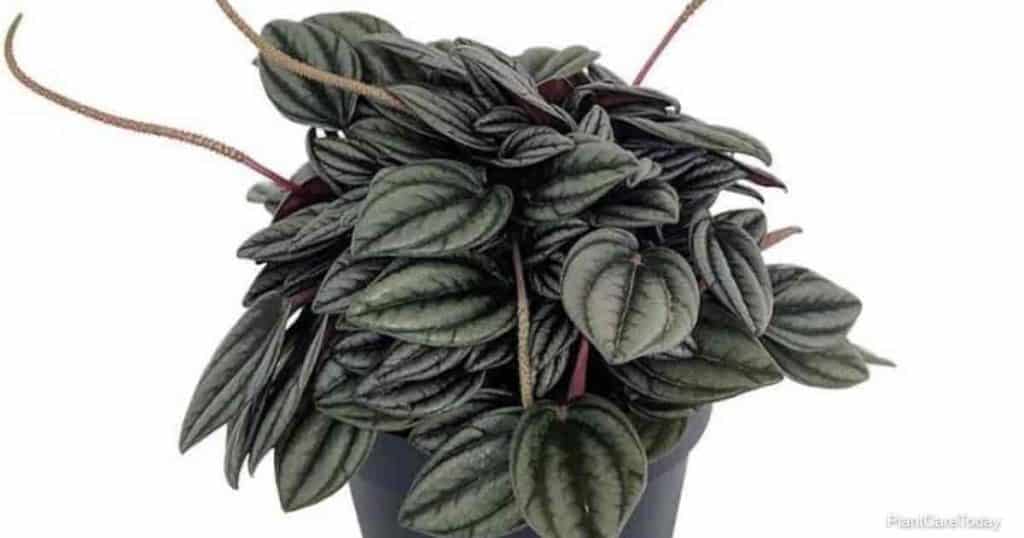The Peperomia Napoli Nights comes from the huge Piperaceae plant family (Peperomia) of over 1,000 ornamental plants.
Peperomia plants originate from the Amazon basin in South America. It is known best for its lush leaves. Its botanical name is Peperomia spp.

Peperomia Napoli Nights is a stout hybrid plant. The cross used a select cultivar of Peperomia peruviana as the female with the pollen from Peperomia marmorata.
Peperomias have a few common names, but the most common name is “the radiator plant.”
Napoli Nights Peperomia Quick Care Tips
- Botanical Name: Peperomia ‘Napoli Nights’
- Pronunciation: pep-er-ROH-mee-uh NA-poh-lee
- Common Name(s): Peperomia caperata ‘Napoli Nights’, Napoli Nights Radiator Plant
- Family & Origin: Piperaceae, Hybrid, South America
- Growability: Easy to grow, perfect for beginners
- Size: 6″ to 8″ inches tall and wide
- Flowering: Produces small, insignificant flowers
- Light: Bright, indirect light
- Humidity: Prefers moderate to high humidity
- Temperature: 65-75°F (18-24°C)
- Soil: Well-draining, peat-based potting mix
- Water: Allow the top 1″-2″ inches of soil to dry before watering
- Fertilizer: Balanced liquid fertilizer, diluted to half-strength, applied every 4-6 weeks during the growing season
- Pests & Diseases: Susceptible to mealybugs, spider mites, and root rot if overwatered
- Propagation: Leaf or stem cuttings
- Uses: Ideal as a houseplant, terrarium plant, or in mixed container gardens
This article will delve into the proper care instructions to make your Peperomia Napoli Nights a healthy and happy plant.
Peperomia Napoli Nights Care
Size and Growth
Peperomia Napoli Nights have a mound growth habit that grows slowly and doesn’t get much taller than a foot. You can plant them at any time, but planting them at the start of spring is best.
The oval-shaped leaves display a grey-green color pattern on the upper surface. The underside of the leaves is pink-red.
Its mounding foliage features an attractive and glossy silver color or grey coloration.
If you grow Peperomia Rosso you’ll love Napoli Nights.
Flowering and Fragrance
What about the Peperomia Napoli Nights Flower? Most variations of the plant produce a brightly-colored flower spike.
The flower has no real fragrance.
Lighting Conditions and Temperature
Napoli Night grows best in shady, humid conditions and prefers medium to indirect sunlight.
They are easy to care for and can grow in most rooms. They need bright indirect light for a few hours each day.
Windows facing south, east, or west provide the best lighting options.
Peperomia Caperata Napoli Nights grow best in temperatures between 65° and 75° Fahrenheit. It should not be exposed to temperatures below 50° Fahrenheit.
If the leaf is dark green, direct sun can damage it. Like most Peperomia plants, Napoli Nights grows well under fluorescent lighting.
Remember, if this plant is left in direct sunlight, the leaves will lose their color.
Add humidity by placing your plant on top of a pebble tray filled with water. Keep your plant away from heating or air conditioning vents.
Watering and Feeding
Napoli Nights Peperomia care requires watering only once a week. Unlike houseplants, this plant needs less water.
When watering, allow the soil to dry out before watering. This translates into watering once a week.
Feel the top 2″ inches of the topsoil with either your finger or a moisture probe tool to tell when the soil is dry. You might even dip these tools in three inches if need be.
If the moisture probe reads 1 or 2, then the plant is too dry.
During warmer months, you can get away with lightly misting the plant.
It’s also best to provide medium humidity levels for healthy growth. You can do this by providing a pebble tray or humidifier.
The thick leaves of the Peperomia Napoli plant store water over long periods, especially in winter.
If the ridged leaves start to yellow or wilt, that could be a sign of overwatering. So ensure there are enough drainage holes to allow the excess water to drain.
Use a diluted liquid fertilizer once every two weeks during the spring. Fertilize once per month during summer. Don’t fertilize during the autumn and winter months.
Peperomia Napoli Care: Soil Requirements and Transplanting
Peperomia Napoli Nights thrive in well-draining soil. But soil mix that’s well-drained also works well.
For this purpose, a peat-based potting mix is best. You can use 2 parts peat and 1 part perlite or sand as well.
Using sand or loam also works.
It’s a good idea to change the soil once a year.
Grooming And Maintenance
Peperomia plants do not have extensive root systems. Repotting often to accommodate root growth is unnecessary. When in doubt, lean toward a smaller pot size to prevent the potting soil from waterlogging.
Consider replanting your peperomia every two or three years to replace the soil.
They look their best when the leaves are bushy. Pinching out the tops of their stems makes plants bushier.
If your Napoli Nights Peperomia grows taller than a foot, it might need pruning. Make sure you use sterilized pruning scissors or knives.
Remove yellowed leaves or extra growth as necessary. Pruning the plant too much can damage its growth.
Peperomia Napoli Nights Propagation
Propagate peperomia using tip cuttings with a few leaves still attached. Place the stem cutting in a small container with fresh, moist seed-starting soils.
The plant should grow in a 68° degrees Fahrenheit (20℃) room with warm, bright light.
We always use a rooting hormone to speed up the rooting process.
New plants can also be started from single two-inch leaf cuttings. Follow the same procedure described above.
Be careful with variegated Peperomia Napoli Nights. They might lose their variegation in propagation. You should allow the leaves or stem tips to dry before planting them.
It might take some experimentation to see which propagation method works best.
Related: More on How To Propagate Peperomia
Peperomia Napoli Nights Pests or Diseases
Luckily, Peperomia care does not involve worrying about many pests or diseases. The plant might lose a few bottom leaves from time to time, but that’s normal.
But, if a plant starts losing several bottom leaves, it could be a sign of:
- Overwatering
- Temperature drop
- Over-fertilizing
- Mealybugs
Check for mealybugs if your peperomia develops cotton-like white masses on the stem or leaf bottoms.
These tiny soft insects surround themselves in white fuzz. Mealy bugs suck the juice from their host plants, causing the plant’s leaves to turn yellow.
You can get rid of mealybugs with neem oil sprays or use a homemade insecticidal soap.
Related: Details on Controlling Peperomia Pests
Peperomia Napoli Nights plants are one of many types of Peperomias to collect, grow, and enjoy.










